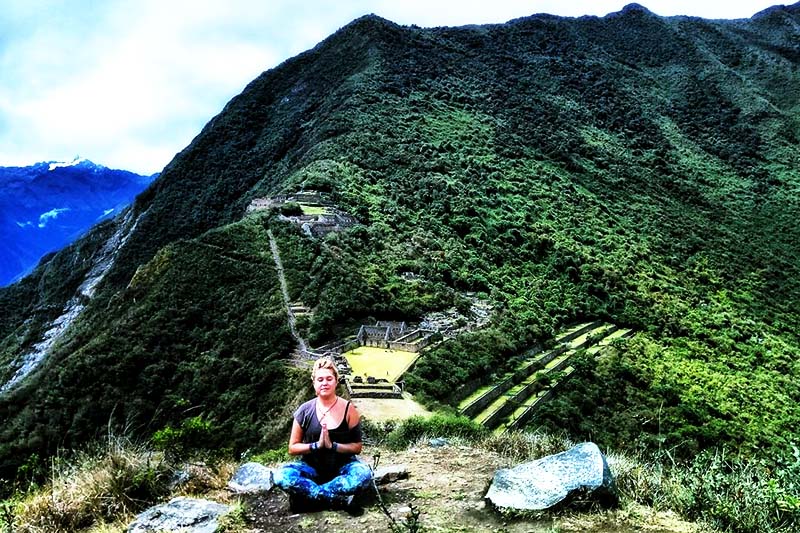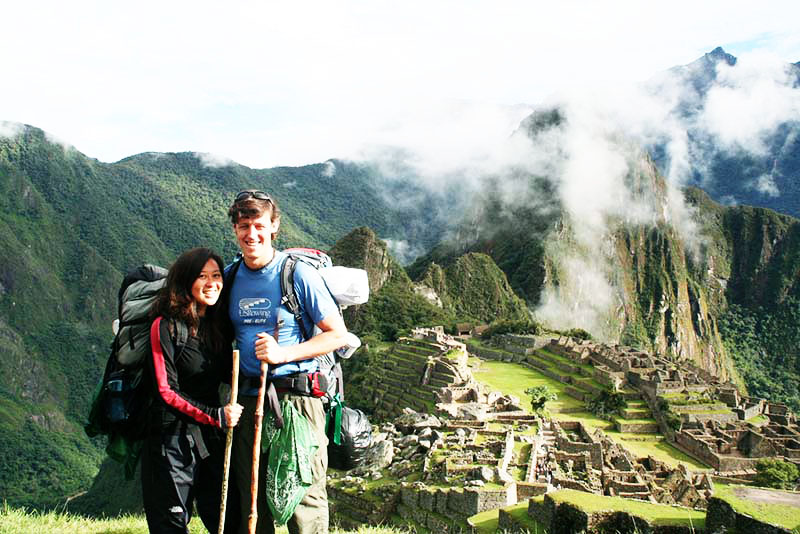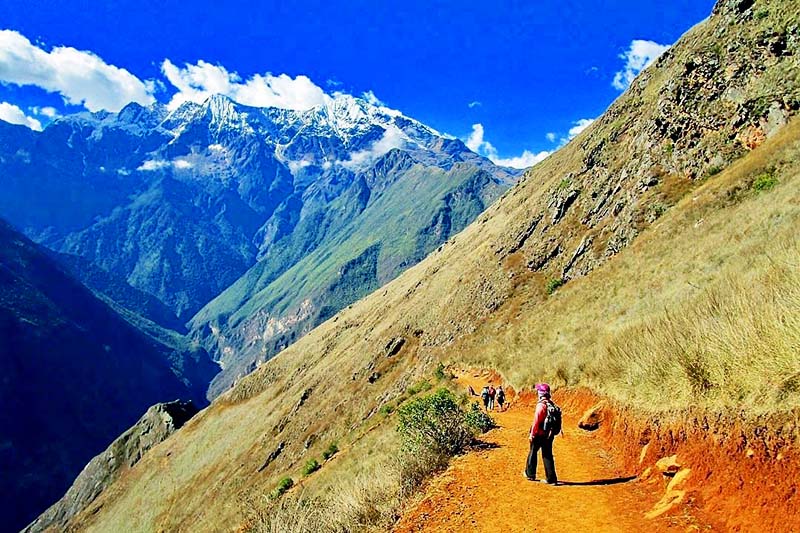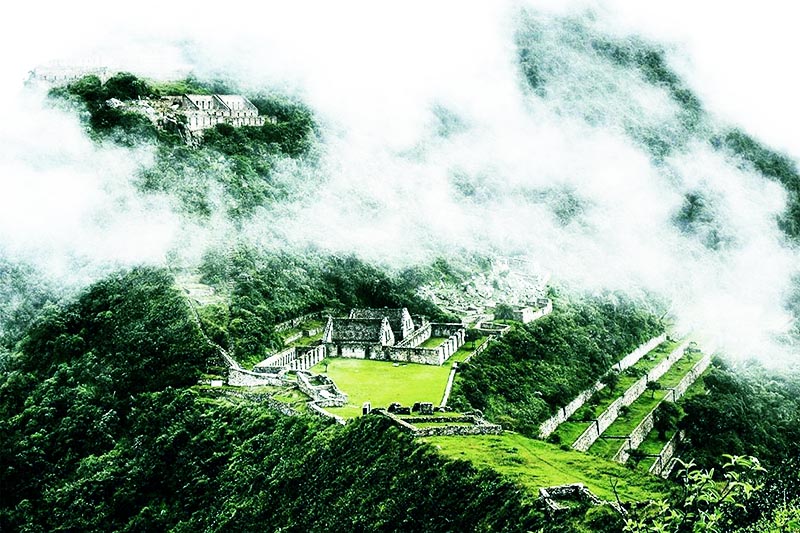Trek Cusco – Choquequirao – Machu Picchu
The most complete and challenging adventure in Cusco is the Cusco-Choquequirao-Machu Picchu hiking route. It is estimated that this hike, little known to tourists, covers a total of 115 kilometers through places of incredible scenic beauty. The most important points of the section are the archaeological complex of Choquequirao, known as the ‘Last Inca refuge’ and the Inca Citadel of Machu Picchu, one of the Wonders of the World. Learn a little more about this 8-day, 7-night adventure through the most hidden refuges of the Incas.
- Choquequirao, the last Inca refuge
- Machu Picchu, Wonder of the World
- Machu Picchu and Choquequirao: similarities and differences
- The hiking trail Cusco – Choquequirao – Machu Picchu
- Other hiking routes to Choquequirao and Machu Picchu
- Recommendations to visit Choquequirao and Machu Picchu
- Questions and answers about visiting Choquequirao and Machu Picchu

Trekking Cusco-Choquequirao-Machu Picchu, one of the most complete and challenging adventures
Why are Choquequirao and Machu Picchu so similar?
Choquequirao is called ‘The sacred sister of Machu Picchu’. There is a similarity between both archaeological sites. This is because they are located in similar geographies in high mountains from where there is surveillance of possible invaders. Both have large agricultural sectors and temples worshiping the sun. Both places were built in the 15th century, so their urban design is also similar.
Choquequirao, the last Inca refuge
- The ruins of Choquequirao are an ancient Inca city located between the mountains belonging to the snowy Salkantay in Cusco.
- In 1909, the American explorer Hiram Bingham visited this place of difficult access. However, it was not until the mid-1970s that the first excavations of this archaeological site began.
- Currently only 30% of the immense site was excavated. Despite this it is one of the most mysterious tourist attractions due to its similarity with Machu Picchu.
- It is known as the last Inca refuge due to the belief that the remnants of Manco Inca were hidden there after the Spanish conquest.
- It is also known as the ‘Sacred Sister of Machu Picchu’ due to the architectural similarity with the Inca Citadel.
- The only way to get there is through a 2-day hiking trail along rivers, high mountains and breathtaking landscapes.
Machu Picchu, Wonder of the World
- Machu Picchu is an Inca site located in the eastern part of the central Andes.
- It belongs to the foothills of Salkantay, in southern Peru.
- It is believed that this site was the urban, religious center and residence of the Inca Pachacutec, who commanded its construction in the early fifteenth century.
- With the Spanish conquest, the place was gradually abandoned until it was covered by the abundant vegetation characteristic of the area.
- In 1911, the American explorer Hiram Bingham made known to the world the importance of the archaeological complex.
- In 2007, the Inca llaqta was chosen as one of the Wonders of the modern World. Since then, tourist traffic has skyrocketed.
- Today, its mysterious stone constructions around beautiful mountainous landscapes are one of the most visited places on the planet.
- It is estimated that around 1 million people visit it a year.
Machu Picchu and Choquequirao: similarities and differences
Machu Picchu | Choquequirao | |
|---|---|---|
| Name | Old mountain | Golden cradle |
| Construction | In the time of Pachacutec (1438 – 1471 AD). | In the time of Túpac Yupanqui (1471 – 1493 AD). |
| Location | In the district of Aguas Calientes, Urubamba province, department of Cusco. | In the district of Santa Teresa, province of La Convencion, department of Cusco. |
| Altitude | 2,430 masl. | 3,033 masl. |
| Function | Citadel, religious site and strategic position for connection of Cusco with the Amazon of the Inca empire. | Citadel, religious site and strategic position for connection of Cusco with the Amazon of the Inca empire. |
| Area | 5 square kilometers | 18 square kilometers |
| buildings | Platforms, terraces, temples, roads, houses and royal enclosures. | The colonial plaza, colcas, platforms, homes, kallankas, ushnus and inca cemetery. |
| Visit | With 1 day tours, 2 days or 4 day hiking route, 5 days or more. | Con tours de ruta de 4 day hiking, 5 days or more. |
| Entrance | 44 dollars for adult tourists | 18 dollars for adult tourists |
| Schedule | Every day from 6 am to 5 pm. | Every day from 7 am to 5 pm. |
| Climate | 8ºC. at 24ºC. | 12ºC. at 24ºC. |

Machu Picchu, the end of this amazing hiking trail
The hiking trail Cusco – Choquequirao – Machu Picchu
- The hiking route from the city of Cusco to Choquequirao and from this point to Machu Picchu is the most complete and challenging one that exists in the ancient ‘Capital of the Incas’.
- Travel through ancient Inca roads surrounded by the most picturesque landscapes. On average it travels 115 kilometers in 8 days and 7 nights of intense trekking.
- The main points are Choquequirao and Machu Picchu. You reach heights of up to 5,085 meters above sea level (masl) to sites of only 2,000 masl
Below is a summary of this hiking route little known to tourists.
Day 1: Cusco – Cachora – Rosalina Beach
- The adventure begins with a trip by bus (3 hours) from the city of Cusco to the town of Cachora in the department of Abancay.
- After lunch, you will go on a 4 or 5 hour walk to the so-called ‘Playa Rosalina’ where you camp and have dinner.
Day 2: Rosalina Beach – Marampata – Choquequirao
- Very early, you leave on foot towards the hamlet of Marampata (4 or 5 hours) where you have lunch.
- Then you continue with a short route (1 hour and 30 minutes) you reach the archaeological site of Choquequirao.
- That afternoon is destined to tour the Inca constructions on this site.
Day 3: Choquequirao – Río Blanco – Maizal
- The day begins with a demanding climb to the Río Blanco sector (approximately 3 hours) where there is a lunch break.
- Then the walk continues to the area of Maizal, where camping and dinner.
Day 4: Maizal – Victoria Mines – Yanama
- This day is not as arduous as the previous one. It ascends for 3 hours to the Abra de Yanama (also known as the ‘Abra Victoria’).
- Then the descent continues to the Victoria mines, where silver was extracted and which is currently abandoned.
- After lunch you descend to the Yanama camp where you spend the night.
Day 5: Yanama – Totora – Collpa
- The difficulty is less that day. It descends through some slopes where you can appreciate the abundant flora and fauna characteristic of the place.
- In the area called ‘Totora’ there is a lunch break.
- Then continue with the walk to the Collpa camp, where there are products offered by the population.
Day 6: Collpa – La Playa
- One of the most relaxing days. It goes up through an open and descends until you reach the camp ‘La Playa’, nominated for the waterfall that refreshes visitors.
- It goes through coffee plantations and banana plantations.
Day 7: La Playa – Hydroelectric – Aguas Calientes
- Very early you start by a regular walk to the Hydroelectric station very close to Machu Picchu (approximately 5 hours).
- After a lunch you will travel for 2 hours in parallel to the Vilcanota River until you arrive at the town of Aguas Calientes, at the foot of the Wonder of the World where you will spend the night.
Day 8: Aguas Calientes – Machu Picchu – Cusco
- The last day is destined to know the Inca Citadel of Machu Picchu. You have breakfast very early (on foot or by bus) to the entrance door of the Wonder of the World.
- After a guided tour of the archaeological site, the visitor will have free time to enjoy the site on their own.
- That day you return to the city of Cuzo on a train trip and then by bus.

Incredible landscape on the trekking towards Choquequirao
The 8-day route that connects Choquequirao with Machu Picchu can be done with an organized tour or on your own. The safest option is to do it with a tour. If you go on your own do not forget to buy your tickets to Machu Picchu.
Other hiking routes to Choquequirao and Machu Picchu
These are some of the most famous hiking routes in Cusco:
- Salkantay trek – Five-day hiking route in its classic version where each tourist travels 70 kilometers on foot to reach Machu Picchu. On the route we also visit the Salkantay Pass, the Humantay Lagoon, as well as the Cocalmayo thermal baths.
- Inca Trail – Four-day hiking route in its classic version where each tourist travels on foot approximately 39 kilometers until arriving at Machu Picchu through the Intipunku or Puerta del Sol. It is famous for traveling the paths of the Incas, the so-called qhapac ñan.
- Inca Jungle – The Inca Jungle is a four-day hiking route in its classic version where adventure sports such as cycling, canoeing, zipline and trekking are practiced. On the route you can also enjoy the thermal baths of Cocalmayo. The last day we visit Machu Picchu through the town of Aguas Calientes.
- Lares trek – The Lares trek is a four-day hiking route in its classic version where approximately 37 kilometers are traveled until reaching Machu Picchu through the route through Aguas Calientes. It is known as the ‘cultural route’ to Machu Picchu as it includes visits to Andean towns with a lot of tradition.
- Huchuy Qosqo trek – The Huchuy Qosqo trek is a three-day hiking route in its classic version where you travel 13 kilometers through the landscapes of the Sacred Valley until arriving at Machu Picchu through the town of Aguas Calientes. It is an easy route and is recommended to visit with children and older adults.
Recommendations to visit Choquequirao and Machu Picchu
- The hiking route of Cusco – Choquequirao – Machu Picchu is one of the most extreme and adventurous experiences in Cusco.
- Tour the 2 most enigmatic sites that the Incas built over 600 years ago: Choquequirao and Machu Picchu.
Due to the physical effort required by the 8 days of trekking, it is necessary to take some precautions.
- Before starting the route it is important to have a previous acclimatization in the city of Cusco. Simply drinking plenty of water and accustoming the body to the height are enough to avoid probable discomfort.
- The walk is of medium-high difficulty. While you don’t need to be an expert mountaineer, it is important to be in a proper physical form to do so.
- The tours that offer this route generally include a specialized guide, food and camping. The visitor must provide sleeping bags, walking sticks and other accessories.
- Admissions to the archaeological sites of Choquequirao and Machu Picchu are also generally. It is recommended to look for an authorized travel agency.
Questions and answers about visiting Choquequirao and Machu Picchu
1) Is it dangerous to visit Choquequirao?
No, Choquequirao is an archaeological site that has many signs. Due to the difficulty of getting there (only with a hiking route), the Inca citadel is almost without visitors, available to tourists. It is a safe tourist attraction.
2) Is there a direct car to Choquequirao?
No, Choquequirao is located in an area that is difficult to access and can only be reached on foot after a walk of approximately 31 kilometers. Ground transportation can take you from Cusco to the community of Cachora, the starting point of the hike.
3) How many kilometers is the route from Choquequirao to Machu Picchu?
The hiking route from Choquequirao to Machu Picchu is 115 kilometers that are done in 8 days on foot and 7 nights in camping and tourist hotels.
4) How high is Choquequirao and how high is Machu Picchu?
The Inca citadel of Choquequirao is 3,033 meters above sea level; while the Inca citadel of Machu Picchu is at 2,430 meters above sea level.
5) Is there a cable car to get to Choquequirao?
No, there is currently a project to build a cable car that can take tourists to the Inca city of Choquequirao in a few minutes. The project is still in progress, but is expected to become a reality in a few years.
6) Which is cheaper to visit Choquequirao or visit Machu Picchu?
Machu Picchu can be visited on your own at a low cost or with a luxurious all-inclusive tour. Choquequirao, on the other hand, can usually be visited on a 4-day hiking route. Therefore, the cost to travel to Choquequirao may be higher.
7) When is the best time to visit Choquequirao and Machu Picchu?
The dry season (April to October) is considered the best time of year to visit Choquequirao and Machu Picchu. This is due to the few rains that make walking easier. The rains are usually intense in January, February and March.
8) Which is bigger Choquequirao or Machu Picchu?
The archaeological site of Choquequirao covers an area of 18 square kilometers (and there are still areas to be unearthed) while the archaeological site of Machu Picchu covers an area of 5 square kilometers.
9) Is the route from Choquequirao to Machu Picchu dangerous?
The route from Choquequirao to Machu Picchu is exhausting since you walk around 115 kilometers. However, if done with a formal tourism agency, the route is safe.
10) Can I do the route from Choquequirao to Machu Picchu on my own without a tour?
Yes, you can do the route to Choquequirao and Machu Picchu on your own. However, you must bring the indicated implements such as: tent, sleeping bag, food, shelter and more. Therefore, the best option – and the safest – is to choose a formal and safe tourism agency.

View of the ancient Inca city of Choquequirao
Advice from people who have been there
 By: Jennifer C.
By: Jennifer C.“The walk of life!“
“Choquequirao may be larger than Machu Picchu. The ruins are less explored and less restored. The beauty is in the walk and the visit to the ruins. I was there at one point completely alone, so there is no comparison with its more popular brother Machu Picchu (5 or 6 days hike from there)“
By Ticket Machu Picchu – Last updated, August 15, 2024